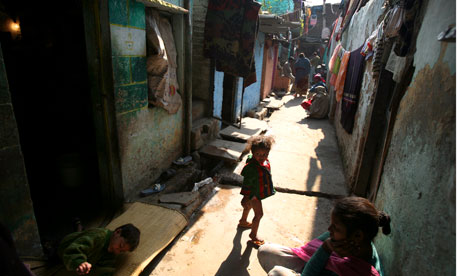 Andy Sumner 27 December 2010 : guardian.co.uk
Andy Sumner 27 December 2010 : guardian.co.uk It's time to focus on poor people – not poor countries
A new approach to reducing poverty is needed in 2011 if people are not to be left behind while their countries get steadily richer
 A child stands in a lane of a slum settlement in the northern part of New Delhi, India. Photograph: Amit Bhargava/Corbis
A child stands in a lane of a slum settlement in the northern part of New Delhi, India. Photograph: Amit Bhargava/CorbisOne little noticed story of 2010 was that five more developing countries officially lost their "poor" status.
When the World Bank carried out its annual reclassification in July, Senegal, Tuvalu, Uzbekistan, Vietnam and Yemen all graduated to middle-income status – countries that have reached the $1,000 (£644) or so GDP threshold.
Taken by themselves, not big news perhaps, but add to that 22 other countries which, since 2000, are no longer considered officially poor, then a quite profound global change is under way: in short, most of the world's poor no longer live in "poor" countries.
China was upgraded in 2001 (based on 1999 data) and India, Pakistan, Nigeria and Indonesia are among the other states that have become middle-income countries (MICs). Only 39 states are still considered to be low-income countries (LICs).
As we enter 2011, it is likely that more will follow. Ghana, for example, looks set to graduate in 2011, particularly in light of its new GDP figures unveiled last month. The country will join Senegal, Cameroon, Angola and Sudan, which are among the growing number of African MICs.
On the other hand, given the lingering reverberations of the global economic crisis, there is also a risk that some countries might drop back under the threshold, slipping once again into low-income status. Pakistan or the Ivory Coast might have cause for concern in 2011, for example.
On the whole, this is a good news story, but with an underside. Yes, there are fewer poor countries but poverty remains high in terms of absolute numbers in the MICs.
The news raises some pressing and difficult questions for aid and development policy. As developing countries get wealthier and are reclassified, many are still characterised by persistently high levels of poverty. Indeed, roughly three-quarters of the world's poor now live in MICs – 960 million, or a new "bottom billion". And this isn't just about China and India. Even if they are removed from the equation, the share of the world's poor living in MICs has still tripled since 1990.
In light of the above, how should global poverty reduction be done differently in 2011?
First, the LIC/MIC binary: If the focus is poor people not poor countries then the LIC/MIC way of looking at the world needs a rethink. The new UN multidimensional poverty measure might be one alternative tool. But there are many others.
Second, the end of aid and the equity elephant: overseas development assistance (ODA) is becoming less important and equity more important. More equitable countries reduce poverty faster, and stubborn asset, gender or identity inequality (ie caste systems) might begin to explain persistent poverty amid wealth in the new MICs. This entails some thinking on what ODA is for. Any attempt to discuss inequality will be viewed as an infringement on political sovereignty but is domestic inequality solely a domestic issue if it hinders the effectiveness of aid?
And could there be a case for a new multilateralism based on putting resources from donors and new MICs together? Keep an eye out in 2011: the fact that the world's poor are increasingly found in MICs has the power to shake up the entire aid and development industry.
http://www.guardian.co.uk/global-development/poverty-matters











No comments:
Post a Comment